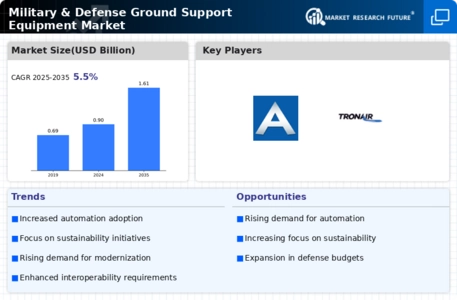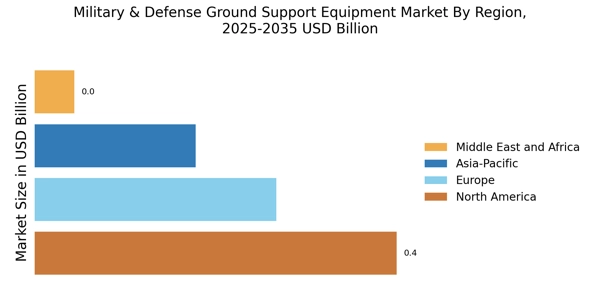Geopolitical Tensions
Geopolitical tensions are a significant driver of the Military & Defense Ground Support Equipment Market. Heightened conflicts and territorial disputes compel nations to bolster their military capabilities, leading to increased demand for ground support equipment. For instance, ongoing tensions in regions such as Eastern Europe and the South China Sea have prompted countries to enhance their defense postures. This environment of uncertainty is likely to result in a sustained increase in military procurement activities, particularly in ground support systems. As nations respond to these geopolitical challenges, the Military & Defense Ground Support Equipment Market is expected to experience robust growth in the coming years.
Technological Innovations
Technological innovations are reshaping the Military & Defense Ground Support Equipment Market, leading to the development of more sophisticated and efficient equipment. Advancements in automation, robotics, and artificial intelligence are being integrated into ground support systems, enhancing operational capabilities. For example, the introduction of automated ground handling systems has improved turnaround times for military aircraft, thereby increasing overall mission readiness. The market is projected to grow at a compound annual growth rate of 5.2% from 2025 to 2030, driven by these technological advancements. As nations seek to maintain a competitive edge, the Military & Defense Ground Support Equipment Market is likely to see continued investment in innovative solutions.
Focus on Operational Readiness
The emphasis on operational readiness is driving the Military & Defense Ground Support Equipment Market as military forces strive to ensure that their equipment is always mission-ready. This focus is reflected in the increasing investments in maintenance and support systems that enhance the longevity and reliability of ground support equipment. For example, the implementation of predictive maintenance technologies is becoming more prevalent, allowing for timely interventions that prevent equipment failures. As military organizations prioritize readiness, the demand for advanced ground support solutions is likely to rise, further propelling the growth of the Military & Defense Ground Support Equipment Market.
Increased Military Expenditure
The Military & Defense Ground Support Equipment Market is experiencing a notable surge in demand due to increased military expenditure across various nations. Governments are allocating larger budgets to enhance their defense capabilities, which includes investing in ground support equipment. For instance, the global military expenditure reached approximately 2 trillion USD in 2025, reflecting a trend towards modernization and readiness. This financial commitment is likely to drive the procurement of advanced ground support systems, ensuring that military operations are efficient and effective. As nations prioritize their defense strategies, the Military & Defense Ground Support Equipment Market stands to benefit significantly from this upward trajectory in spending.
Sustainability and Environmental Considerations
Sustainability and environmental considerations are emerging as critical factors influencing the Military & Defense Ground Support Equipment Market. As military organizations face pressure to reduce their carbon footprints, there is a growing trend towards the adoption of eco-friendly technologies and practices. This includes the development of energy-efficient ground support equipment and the implementation of sustainable logistics practices. The market is witnessing innovations such as hybrid and electric ground support vehicles, which align with global sustainability goals. As these initiatives gain traction, the Military & Defense Ground Support Equipment Market is likely to evolve, reflecting a commitment to environmental stewardship while maintaining operational effectiveness.


















Leave a Comment